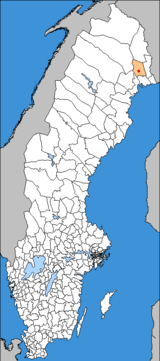Överkalix study
The Överkalix study (Swedish: Överkalixstudien) was a study conducted on the physiological effects of various environmental factors on transgenerational epigenetic inheritance. The study was conducted utilizing historical records, including harvests and food prices, in Överkalix, a small isolated municipality in northeast Sweden. The study was of 303 probands, 164 men and 139 women, born in 1890, 1905, or 1920, and their 1,818 children and grandchildren. 44 were still alive in 1995 when mortality follow-up stopped. Mortality risk ratios (RR) on children and grandchildren were determined based on available food supply, as indicated by historical data.

Among the sex-specific effects noted; a greater body mass index (BMI) at 9 years in sons, but not daughters, of fathers who began smoking early. The paternal grandfather's food supply was only linked to the mortality RR of grandsons and not granddaughters. The paternal grandmother's food supply was only associated with the granddaughters' mortality risk ratio. The grandmother having a good food supply was associated with a twofold higher mortality (RR). This transgenerational inheritance was observed with exposure during the slow growth period (SGP). The SGP is the time before the start of puberty, when environmental factors have a larger impact on the body. The ancestors' SGP in this study, was set between the ages of 9-12 for boys and 8–10 years for girls. This occurred in the SGP of both grandparents, or during the gestation period/infant life of the grandmothers, but not during either grandparent's puberty. The father's poor food supply and the mother's good food supply were associated with a lower risk of cardiovascular death.[1]
Only the female probands experienced a twofold higher mortality RR when the paternal grandmother had good food availability during her SGP, compared to the mortality risk of those whose paternal grandmothers had poor food supply during the SGP.
Using the same data, another investigation highlighted that a sharp change in food availability in paternal grandmothers' resulted in an increased risk of cardiovascular mortality in granddaughters adults' life.[2] Such an effect was not observed in other grandparents. The grandparents were considered exposed if they experienced drastic change in their early life ranging from embryo to 13 years old.
Sex-specific effects can be due to parental imprinting a process that results in allele-specific differences in transcription, DNA methylation, and DNA replication timing. Imprinting is an important process in human development, and its deregulation can cause certain defined disease states of other imprinted human disease loci. The establishment of parental imprints occurs during gametogenesis as homologous DNA passes through sperm or egg; subsequently during embryogenesis and into adulthood, alleles of imprinted genes are maintained in two "conformational"/epigenetic states: paternal or maternal. Thus, genomic imprints template their own replication, are heritable, can be identified by molecular analysis, and serve as markers of the parental origin of genomic regions.
The estimation of percentage of human genes subject to parental imprinting is approximately one to two percent, currently parental imprinting has been identified in fewer than 100 distinct named genes.[3]
See also
- Dutch famine of 1944
References
- Lalande, M. (1996). "Parental imprinting and human disease". Annu Rev Genet. 30: 173–95. doi:10.1146/annurev.genet.30.1.173. PMID 8982453.
- Bygren, LO.; Tinghög, P.; Carstensen, J.; Edvinsson, S.; Kaati, G.; Pembrey, ME.; Sjöström, M. (Feb 2014). "Change in paternal grandmothers' early food supply influenced cardiovascular mortality of the female grandchildren". BMC Genetics. 15 (1): 12. doi:10.1186/1471-2156-15-12. PMC 3929550. PMID 24552514.
- Kaati, G.; Bygren, LO.; Edvinsson, S. (Nov 2002). "Cardiovascular and diabetes mortality determined by nutrition during parents' and grandparents' slow growth period". Eur J Hum Genet. 10 (11): 682–8. doi:10.1038/sj.ejhg.5200859. PMID 12404098.